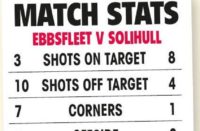Read Part One here
The National League System is one of English football’s crown jewels and the envy of the game around the world. In this second part of our round table feature, we look at what makes Non-League football so special and the role that it plays in all aspects of the community.
The NLP‘s editor Alex Narey and senior writer Matt Badcock joined the head of League and Club Services Laurence Jones, FA Leagues Committee chairman Ray Lewis, National League System manager Matt Edkins, former Conference champion and Glebe boss Anwar Uddin, now The Football Supporters’ Federation Diversity and Campaigns manager, and Tring Athletic‘s Liam Irons, who also represents the England Cerebral Palsy team, to discuss all things Non-League football.
Up for discussion here was diversity in football, Non-League Finals Day and what makes the game at this level so appealing.
The NLP: We thought we’d start with something light-hearted. There are lots of serious issues in Non-League football but we’re all in this because we love this level of football. So let’s start with why we put our heart and soul into Non-League football.
Laurence Jones: Like many people, I’ve been in the game for over 50 years in various roles. For me, the power of football is the empowerment of people. We can lose sight of the impact Non-League clubs have in their community. The focus is often on the top end of the game – and there’s nothing wrong with that. But, actually, in local communities up and down the country, that role of a Non-League football club is immense.
At my own club, Market Harborough, we’ve got 48 teams. We’re going from five-year-olds through to veterans so it’s a real community environment. We’re seeing that model across the country.
So it’s about taking football to the heart of local communities. Also, seeing it through the eyes of players, supporters, administrators. I think it’s a way of galvanising a community.
I’m really, really proud of The FA’s National League System. No other federation in the world can create an environment where a team can start on local parks and – with a lot of luck and a lot of dosh – can find their way to the Premier League.
That is one of our Golden Nuggets of football in this country. Everybody who plays a part in that, whether it’s a player, chairman, tea lady, clubs, are part of the family. That is worth protecting and promotion.
It’s fun, serious fun because the game is changing, but it’s about bringing football to the local community.
Anwar Uddin: I started at the very top in the Premier League with West Ham and had a career that spanned the whole of the Pyramid, ending up in the National League South, which was the lowest I went as a player.
But even at the two clubs I was at then – Eastbourne Borough and Sutton United – it was so professional and we had fantastic players. It’s an extension of the Football League.
Traditionally, in years gone by, it’s been the Football League and Non-League – like two separate entities. But I think now people are happy to drop down and play in the Non-League system because clubs are professional, they’re community based, the football is a great standard, so is the coaching. So why not? If it’s local to you and it’s run right, it’s a great avenue to play.
My full-time job is with the Football Supporters’ Federation, leading on the Fans’ Diversity Campaign but I’m manager now at Glebe FC in the Southern Counties East League at Step 5. The amount of clubs we come across, the professionalism, the standard of players and the way the league system is run – you wouldn’t think in terms of the whole Pyramid that we were as far down as the ninth tier. You go across the world and other countries don’t even have that organisation at the very top level. So I think we should be very proud of our Non-League System.
And as someone who is an aspiring manager, someone who is learning their trade, it’s a fantastic place to do that. I would encourage all ex-pros who look at a career in management – they always tend to want to stay at the highest level – learn your trade at any level. The standard at the lower levels is fantastic. It’s a great breeding place for development.
As an ex-pro I’m able to call on some other ex-pros to help me out. So I’ve got Peter Sweeney playing for me who has played in an FA Cup final for Millwall against Manchester United. He’s now playing for Glebe and enjoying it.
LJ: To the uninitiated they really don’t know how good this level of the game is. And the commitment the players and coaches put in. I don’t think my club have had a Tuesday off from August through to Christmas. You’re asking boys to do a full-time job, travel to games, it’s phenomenal. It’s well-structured, professional, grounds are a really good standard – it’s a great environment to watch football. It creates a bond between supporters and players.
AN: There’s a connection with what you’re watching. It’s not just watching a game to see the final result. It’s more than that.
LJ: I had a father and child come up to me about a year ago. He said, ‘My child enjoys watching this level of football more than the Premier League. Because he can speak to the players’. There’s a relationship there.
Ray Lewis: That’s a tradition of Non-League football isn’t it. You can go in the bar afterwards and there’s this liaison where they are part and parcel of the club. You probably don’t get that in the pro game now where the home team even arrive on a coach and they’re ushered into the changing rooms. In the old days they would turn up in cars, the autograph books would be there where people would sign before they go into change or after.
So the enjoyment of Non-League football has been raised because they’re not getting that type of thing at the higher level.
With my refereeing background, the Pyramid system has definitely helped the progression of clubs, but it’s also definitely helped the progression of referees. People can be graded and gradually climb the ladder with confidence they are now competent at one level to go up to the next level. If you ask the PGMO, the move out of the National League into the Football League is not as great as it used to be because of the level of football at Step 1.
Liam Irons: As a player you don’t just play for a team, you play for the community as well. You feel involved with the whole thing. You’re not just going and playing for the sake of it, you’re playing for the people in the bar. It gets you in the community. The spirit drives clubs forward.
AU: I remember in my first year of this job I went to Manchester United to do some work for Show Racism the Red Card. I got back into London on the train, jumped in the car to play at Bognor Regis for Eastbourne Borough. I was driving home thinking. ‘I played in the Premier League 15 years ago!’ Even playing at somewhere like Truro – it was a mission for me to get to Eastbourne from Kent first. But as players – and coaches and managers – you accept it because that club and the league system provide you with that platform and you appreciate that. It’s not going to be perfect.
You may have to travel. But, like I say to my players, you have to get used these barriers. Because when you do step into the Football League, there are no barriers. You are going to Morecambe on a Tuesday night, Carlisle do play Plymouth. If you can’t handle that, you don’t belong there. In terms of an apprenticeship that’s a good thing.
Don’t get me wrong, the financial side of it is hard. I remember Bishop’s Stortford playing in the Conference North. It’s difficult financially, massively, but it adds character to the players.
Non-League players just get on with it. I guarantee a lot of the players who play at the higher levels couldn’t do that. For me, it shows Non-League players have that added character. That comes from the fact they are working all day and then doing something they love. That’s where that purity comes in. I go to my club Glebe, we have people doing the kit, washing it – they’re not doing that for any financial gain. I’m not there to earn money. You’re there because you want to be there. The professional game can learn a lot from that aspect of character, desire and passion. Some of the players I played with at the top levels, if they had a little bit of that, they’d end up playing even higher.
LJ: There is a group of people in Non-League football – club administrators, the people who wash the kit or prepare the ground – they are incredible. They do not get the recognition they deserve. These clubs are their life and we should never lose sight of that. These people are absolutely the heartbeat of football in this country. They don’t get paid, they do it for the love of the game, the love of their club. Rewarding and recognising these people is so important.
RL: And they’ve done 25, 30 years of service to one club. They’ve been there.
LJ: Sometimes, because we are so busy running football, we can lose sight of the human element. Without these people there wouldn’t be these clubs. They are so valuable and so important to the game.
ME: It goes back to Mark Harris’ comments in The Non-League Paper a few weeks ago – £20,000 or ten volunteers? There’s no competition.
LJ: If you went back 20 years a football club is a football club. Now, at these levels, they are also businesses. You actually need different skills. We now live in a world of social media. Clubs who can’t get on the social media trail get left behind. The whole world is still happening around football. Clubs have to be able to embrace some of that and that’s a real challenge. Keeping that real volunteer culture but also introducing new skills so that football survives in the modern world.
ME: We’re doing a piece of work with Mark Bradley around fan engagement, assessing a club’s volunteers and actually aligning people to the right positions. A lot of people over time have just assumed a role at a club. By realising what volunteers they have and realigning them into different positions, clubs can get better outcomes.
RL: We must mention that the volunteer workforce is gradually diminishing. The drop-out at local district level football is simply because the guy running the club for 30 years has had enough and no one wants to take it over. That’s the sad part about it. When you look at the 11 v 11 game, people have different challenges.
AU: In short my job is about making football as inclusive as possible and getting more people to watch football, ideally locally. One of the things I’m working on is this untapped talent pool of people who love football. Not just going to watch football but also get involved in the clubs.
Aldershot, for example, and the Nepalese community that’s around the club. Now they probably don’t enjoy watching football as the bulk of the Aldershot fans, but because they’re so close to the club, get involved on a match day, use the facilities. Linking into communities that probably don’t embrace football as much as others could be a way to look at that issue. If we’re encouraging more people to get involved in the game, it’s not just about playing or watching, it’s about every aspect of the game. At the lower levels, if you haven’t got volunteers, everything just falls to pieces.
LJ: Being involved in a football club is a really great way to get life skills. Lots of clubs have youth sections linked into the adult sections. How do we engage with those older younger players, if that make sense, and get them involved with the club. Not only does it help their self-development as young people, it gives them a purpose. We have to engineer that, we have to help that. Part of our strategy around club hubs is to develop clubs at this level of the game.
Our World Cup heroes
NLP: Liam, as well as Tring Athletic at Step 5, you also play for England Cerebral Palsy.
LI: I only found out about the England Cerebral Palsy team within the last three years. I only played district standard Saturday football and the opposition manager had cerebral palsy. He said to me, ‘Have you ever tried to get in contact with anyone about playing for England?’ I didn’t know there was a team. So I got in contact with Jeff Davis, who is The FA’s Head of Elite Development in disability football, and was invited to a training camp at St George’s Park. That year was Paralympic year so I went to Rio. Last year we went to Argentina for the World Cup, where we finished fourth – the highest every finish.
From that I’ve moved up to Tring Athletic. A lot of my team-mates play in the National League System and one plays out in America.
NLP: There must be lots of other players out there who have cerebral palsy but don’t know about the team.
LI: I’m sure there are – and that’s what the FA are trying to change.
ME: Jeff says – and we did some work with leagues at our summer Leagues Conference, that there are quite a number of players in the system with different disabilities who are eligible for a myriad of teams we’ve got based at St George’s Park.
NLP: How does it feel to pull on the England shirt?
LI: It’s brilliant. Going from Saturday football to that is amazing. You’re playing with your mates and then all of a sudden you’re playing for England. It’s amazing.
NLP: Playing for your country must be really special. We often keep in touch with former England C players and they were all really proud to have worn the shirt. Anwar, you had a big hand in England C’s friendly with Panjab FA at Solihull Moors last summer didn’t you?
AU: It was probably one of the highlights of the year for me. That game was great for football, but also diversity. It showed inclusion, awareness, for everyone. The FA are so receptive to doing what they can to not only promote diversity in the game, but also look at the Panjab FA players. They are also playing in the National League System so it was a celebration really of what football is.
To have 2,500 fans at a ground and the majority be non-white was a magical thing because it’s not something you will see at every game. That game galvanised the Punjabi community. We’ve got supporter groups in the midlands – Punjabi Wolves, Punjabi Rams, APNA Albion – they were all there. For them it was great to see not only Panjab, but also England C and the standard of players. The best thing about the whole day was the game itself – it was a very good game.
The Panjab FA players have flitted around Non-League but they really rose to the occasion. England C obviously had real quality.
For me the England C team has always been the pinnacle of the Non-League game. One year I got called up to England C the same month I got called up to the Bangladeshi national team.
The difference was England C were playing in the Four Nations and Bangladesh were playing in the Maldives! But John Still said, ‘You’re not going because you’ll be away too long! If you want to play for England C that’s fine’.
NLP: It’s probably worth doing what John Still says!
AU: He was my manager for eight years! But playing in the Conference for Dagenham, in the back of everyone’s mind was getting in that England C team at the end of the season. I know it’s now used to look at the younger U23 players, but when I was 25 or 26 it was like, ‘OK, I’m at this level now, what’s the best I can do?’ Winning the league, which I did, but I also wanted to get in that England C squad. If you’re an English player in the Premier League, you want to play for England – it’s no different in Non-League. I think that says a lot about what England C are all about.
From a personal point of view, one of the greatest things I’ve felt with the England C team is that if there’s a 19-year-old lad playing in the National League South and standing out, even though he’s playing in the league below the National League, they will still be picked. It helps them massively and gives them a platform.
NLP: It’s a unique opportunity to play against other countries and have that experience too.
LI: When we played the Brazilians, they would make weird noises. So when they wanted the ball passed, they’d squeal! We didn’t know what was going on! But it’s great for your development to experience different styles.
AU: I played at every level coming down from West Ham to Dagenham. I’d worked with John Still for two years at Bristol Rovers and three years at Dagenham. We had a very aggressive, direct style of playing. That was fine by me, I did well at that and I preferred that because it complemented my game. Having been at West Ham and getting the education of playing out from the back, I didn’t do that for years. Then I went to do some training with Paul Fairclough (England C manager) and he’d say, ‘Come out from the back with the ball’. ‘Really? Wow, this is brilliant’. I felt like a schoolboy again. That’s the beauty of Non-League – everyone does it their own way. ‘How can we get success? We can’t get the best players in the world, how do we form a team or a way of playing that gets us success?’
I commend that, it’s brilliant.
Finals Day is here to stay
NLP: Finances have always been, and will always be, a big talking point in Non-League football. From the FA’s point of view, there was good news recently with the announcement that the FA Cup prize fund is set to be increased. What is that going to do for clubs?
LJ: The prize funds in the FA Cup, Trophy and Vase are really important. It’s a good investment of FA monies into this level of the game.
NLP: Is there an argument that some of this money should be ring-fenced? Of course clubs earn the money and can spend how they like, but should some of it have to into facilities rather than on a new striker?
LJ: There’s a big debate on that. If you’re asking my own personal view, I’m favour that. I think a percentage should be ring-fenced for investment in the club. Other people will have a contrary view. But there is a debate and it may be one that comes to the table at some stage.
AU: It does happen. Unfortunately someone lost their job at Glebe, the club I went into. They’d just come off the back of a very good run for a Step 5 side. In the league they were second from bottom. But they’ve purchased floodlights for one side of the stadium off the back of that cup run, which they never would have been able to do. Our club is a very new club, the facilities are beautiful, but they come at a price. That FA Cup run has probably saved five years of crowdfunding, fundraising, to get that. If used in the right way it can be massive for a club. The only negative about that is it puts a bit of pressure on the manager!
LJ: I think there is a compelling argument some of the prize money should be ring-fenced and re-invested into the club because it gives a club a better return on their investment. It enables them to have a new set of floodlights, a better pitch or whatever. It’s hard to argue against that.
ME: They can use it for innovation.
LJ: I think most clubs would welcome it. Not all. But it’s really positive prize funds are being addressed.
NLP: Non-League football will always feel the money that comes down isn’t enough and question why Manchester City, for example, need the £1m prize money for winning the whole competition. But Andy Ambler (the FA’s head of professional game relations) explained to us that there has to be a balance because they are the clubs that bring in the big TV deals.
ME: Those are the clubs that get the global rights.
LJ: It demonstrates the FA’s commitment to invest in this level of the game. Everyone will always want more. There’s never enough money in the pot to please everyone. The fact the FA is increasing and investing more has got to be positive for all the clubs at this level.
NLP: Our columnist, Ian Ridley, recently wrote about how the FA are caught in the middle. All of the responsibility but it’s the Premier League who hold the money. Do the Premier League put in more than people realise?
LJ: Through the Premier League, the FA, the EFL, there’s a lot of money invested in football outside of the professional game. There’s continued streams of investments that come in all different shapes and sizes. Not all of it has visibility. We look at the community schemes, the work Anwar does – all of this comes at a cost. I think football has to be very careful not to be over critical of the professional game because the professional game does make investment.
What we’re trying to invest in is a very large cohort of the game. If you think nationally, there’s 22,000 clubs, 89,000 teams. All those clubs and all those teams will make a compelling argument about needing more investment. So we have to be careful. The professional game does invest in football.
The FA Cup, you’re absolutely right, whether we like it or not, it is the clubs at the top of the tree who attract the TV rights. The very fact we have a structure in this country that allows investment created by that to come down to the clubs right the way down to Step 6 – we have Step 6 clubs in the FA Cup – isn’t that a testament to our system in this country? I don’t think that happens in many, if any, other federations. It’s a balance.
Yes, everyone sees the telephone numbers involved in the top end of the game. Without that top end of the game, we must recognise there is investment being driven through all sorts of activities. The work Anwar does is absolutely priceless, but it comes at a cost doesn’t it?
AU: Almost definitely. The money that football does attract, in various ways, it’s about how you reinvest that to positively affect everyone engaged in football. I’m a player so I’m biased – players are a big part of the game – but also football has a responsibility to look at staff, look at fans, look at communities. That’s only right.
It’s been so surprising for me because you don’t see the governance side as a player. The work that goes on, the meetings, the travelling people do, just to make competitions. Players can turn up, play, go home – win, lose or draw. The amount of detail that goes into that fixture, in that league, at that time, is absolutely amazing. I commend everyone who works under the radar. Players take it for granted. If the leagues and competitions are run well we should be grateful for that and anything we get in terms of finances is a luxury and a bonus.
Don’t get me wrong, I was at Sporting Bengal as a manager and we had a great run in the Vase. That sorted the club out for years. They knew they could pay for the rent, get kit. We had to have a good run to achieve some money and not all clubs do that because it’s difficult. But the possibilities are there.
We talked before about how a team in this country can go from Step 6 to the Premier League. It might not be a reality, but it’s a possibility.
LJ: Fleetwood are an example, they’ve gone from Step 5 to League One and they’re doing well. The FA makes an investment into grass-roots football. The new funds are coming from the FA Cup deals. That’s being spread across increased prize funds, more money going to facility development, more investment into club hubs, coaches for young players.
The challenge for football, in many respects, is the sheer scale of it. We lose sight of how big it is. 89,000 teams in this country, 22,000 clubs – that’s a big wedge of football.
NLP: You had a good run in the FA Vase this season with Tring, Liam.
LI: It’s a great competition. We’ve got a player called Chris Vardy, who always seemed to score in the FA Vase. The hashtag on twitter has been #FAVard – he’s loving it. It’s good to play against different clubs around the country, have away days and make the most of it.
LJ: Non-League Finals Day is on Sunday, May 20.
NLP: In the first two years, has it met the expectations of what you’d hoped to achieve?
LJ: Massively. If you look at the attendances for both years, the games have been really good, the atmosphere it has created for Non-League football has been good. It’s a celebration of Non-League football, that’s what we’re trying to create. They are the top two Non-League competitions and, yes, it’s absolutely achieving what we hoped. The feedback we’ve had from fans has been really positive. It’s a great day out – two really good games of football, the most iconic stadia in the world, reasonably priced. Last year we had pop-up pubs on the concourses. We’re trying to make it even more of an event, but we’re really pleased.
Prior to Non-League Finals Day some of the recent Vase finals’ attendances were 5-6,000. You’ve got to look at the logistics of opening a stadium of this size.
The two attendances across Non-League Finals Day have been phenomenal.
NLP: Lots of people will say the FA should just absorb that cost, because it’s crucial the Vase final is played at Wembley.
LJ: And that’s why Non-League Finals Day works. Do I think it will go back to separate finals? No, I hope it doesn’t. Non-League Finals Day is a calendar event now. It promotes this level of football.
It’s good to see fans mixing and I thought last year more fans stayed on to watch the second game than the first year,.
ME: That’s one of the challenges, to get people to stay for the second game.
LJ: That’s what we’re consistently working at.
NLP: Both games last year where really enjoyable, especially Macclesfield v York.
LJ: Definitely. In the first year we were in a hotel after and there was a Halifax supporter in there who told me what a great day it had been. He said, ‘My 90-year-old father came down on the Halifax supporters’ bus. He’s blind but I was able to come to Wembley with my dad’.
AU: You can attract the neutral when it becomes an event. We encourage people to come along and just watch two finals at the best stadium in the country.
LJ: Neutral sales increased between the first two years. That’s the area we need to focus on. You’ll always get the finalists’ supporters – no one at this level is going to miss watching their team at Wembley – so it’s how we grow the neutral support. Working with Anwar and being more creative.
Reader questions
How can you ensure Step 5 doesn’t become weaker with the extra clubs that are promoted?
This is the very reason any planned changes take time, with a minimum of a playing season’s notice. From afar, this can come across as The FA taking their time, but it is for good reason. We are in a great position with the Step 5 leagues having done sterling work to ensure we have robust numbers.
We’ve heard all the Step 3 & 4 changes but how will promotion & relegation work into Step 2 from 3, into Step 3 from 4?
It is proposed that Step 3 to 2 will be managed with a ‘super play-off’ system. Step 4 to 3 is slightly more complex and it is acknowledged that a temporary measure will have to be deployed until the 8th division is created. In both cases the regulations have not yet been approved, so more details will follow.
With ground-grading, if the leagues enforce the rules, can the FA step in if certain criteria is just unrealistic for a certain level, like at Step 6 where the crowd numbers are so small?
When ground grading was created the NLS leagues agreed to the various standards across the system and, in the main, this has resulted in high level facilities being created. The criteria sits with The FA’s ground grading technical panel, but they have to be mindful of the level clubs have aligned their grounds to and watering down would be a waste of clubs’ finances.
Power of football
NLP: Anwar, what are the diversity challenges football is facing?
AU: It’s almost like a new pool of work football, due to investment, is now looking at seriously. From a personal perspective, I played at Bradford six years in a row when I was at Dagenham and Barnet. They were in the same league as us and had 15,000 every single week. The club is surrounded by a huge Bangladeshi community. I’m no Jamie Vardy but I thought if I was playing at Valley Parade and I’m Bangladeshi, surely that is a reason for the local community to say, ‘I don’t go to football, but someone who’s from the same country as me is playing, I’m going to go’. Not one year did I see one face.
So when I first got this job at the Football Supporters’ Federation, it was one of the first clubs I went to, just out of curiosity. I went to the community centres, I went to the mosques and three years later we created a supporters’ group called the Bangla Bantams and purchased 60 season tickets home and away.
There’s a group of 300, they go to most home games, but the core group also go to away games. You’ve got elderly women in hijabs, elderly men. Young boys and girls, who were playing football and going home when the football fans came in. When the football fans went, they came back out. There was a total disconnect. All of a sudden that is changing. It has taken a lot of work, time and effort.
With some clubs, especially in the lower leagues, they have skeleton staff. Even a club the size of Bradford only had six full-time staff and they were more worried about staying in the division.
Great stadium, but the changing rooms had a shared toilet. Man United playing in the Premier League and the toilet was shared! That’s now changed, but only last year. So clubs have so many problems as it is to keep afloat, looking at how they increase the gate in general is a luxury, but looking at how to increase the diversity of the gate is even more of a luxury.
That’s where the Football Supporters’ Federation comes in. We’ve agreed with the FA to have a concerted effort from National League down. A lot of our work is, not specific to the Premier League and EFL but you can imagine the volume of fans, but now we’re working on a partnership with the FA to say: How can we get more people watching Non-League? That’s from all the communities – LGBT, disabled friendly and every aspect of society – what can we do to get these people look at volunteering, for example?
We have a fund which all clubs are able to utilise. This goes back to finances. Football does reinvest back into the grass-roots, but there’s just so many aspects. It’s not just cup runs.
But a Non-League club can now benefit. If you’re attendances are falling and you want to get it up by 100, contact me and we can look at that, in partnership with the FA.
It’s great to still be involved in the game on that aspect, and it’s really interesting. But I’m addicted to Non-League football and that’s why on a Tuesday and Saturday I’m screaming on the sideline!
NLP: Liam, have you found the pathways better now?
LI: I think it can be out there a bit more. If I didn’t know there was a cerebral palsy England team two years ago and I’ve got cerebral palsy – but I know that’s what the FA are trying to do. I’m getting involved with the FA People’s Cup in local communities to try and help that.
LJ: It applies to most sports, but the power of football is absolutely immense. We can underestimate how powerful it is in breaking down barriers and creating communities. If we really get it right we could really unleash something really positive.
AU: It’s important people understand and ask questions about how the FA, Kick It Out, your league, your County FA can actually help. Footballers and coaches and managers don’t always realise there are support mechanisms. Whatever aspect or issue, there is support there. If there’s not, football will create something to make sure there is. If you’re not sure, just ask questions because it could benefit you long term.
LJ: We have to get better at giving visibility to those challenges. Football still suffers a little bit from managers and players thinking that an FA or a County FA deals with discipline and all they do is fine. If you asked 100 players that’s what they’d say. We’re working hard to change that perception.
AU: As you said Liam, there are undoubtedly loads of players similar to you. It’s finding out because people will be surprised how much support is there.



























